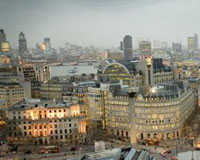Slowing capital value growth and diminishing total returns did not deter investors from piling into UK property in Q3 according to figures released today by the IPD.
The UK Quarterly Property Index found that purchase activity increased 14.6% in the three months to the end of September as investors looked to UK real estate “as a relative safe haven during very uncertain times”.
UK funds chasing income return were prominent purchasers in the quarter when capital values rose just 0.3% and total returns totalled 1.8% as slow economic performance in the UK was passed on to values through declining occupier demand.
In Q2 the IPD index recorded a total return of 2% and a 0.5% increase in capital values.
The stagnating economy, increasing inflation, austerity measures and general uncertainty about the UK’s ability to avoid recession have all led to rental growth tailing off to just 0.1%.
The retail and industrial sectors strayed further into negative territory both recording negative growth of -0.2%.
IPD research director, Malcolm Frodsham, said the increase in purchase activity came “despite fears that too much stock was becoming available, particularly in central London”.
He added: “Buyers are not just high net worth individuals and international investors, various UK funds have also been investing, chasing the now all important income return.”
Authorised property unit trusts were the largest investment group during the quarter when net investment totalled £1.5bn – or 1.3% of the IPD Quarterly Universe’s total capital value.
Net investment into alternative assets rose markedly over the period, at £402m or 5.9% of the segment’s total capital value.
The “other” segment includes healthcare assets, student accommodation, hotel and other leisure properties, and is now larger than the IPD regional office segment and the City office segment, as investors look to increasingly diversify their portfolio.
Over the last 12 months the size of the segment has increased by 21.3%.
IPD research director, Malcolm Frodsham, said: “The impact on consumer spending has been quite severe, and thus the retail sector is one of the hardest hit, as people have less money in their pockets.”
Shopping centres saw a decline in values for the first time since September 2009, down -0.4%. Rental falls for the segment, which have been ongoing for 12 consecutive quarters, now amount to 11.1%. Standard high street retail units outside of the South East, have now seen a cumulative fall in rents of -10.6%.
Overall the retail sector recorded 0.1% capital growth for the quarter, as there have been positive retail stories, but only in the West End, retail warehouse, and supermarkets segments, and even here growth has been slowing.
“Supermarkets are one of only two retail segments in our index that have seen an increase in capital growth, to 0.8%, due to their a-cyclical tendencies in a period of falling consumer spending,” Frodsham added.
Office performance has been muted. Central London capital growth, which buoyed the sector throughout the recovery, has started to decline, down to 1.1%, from 2.8% last quarter.
Outside of London, growth was negative across all areas, though capital declines were slowing in the South East, while rental values were, for the majority, in decline.
bridget.oconnell@estatesgazette.com











